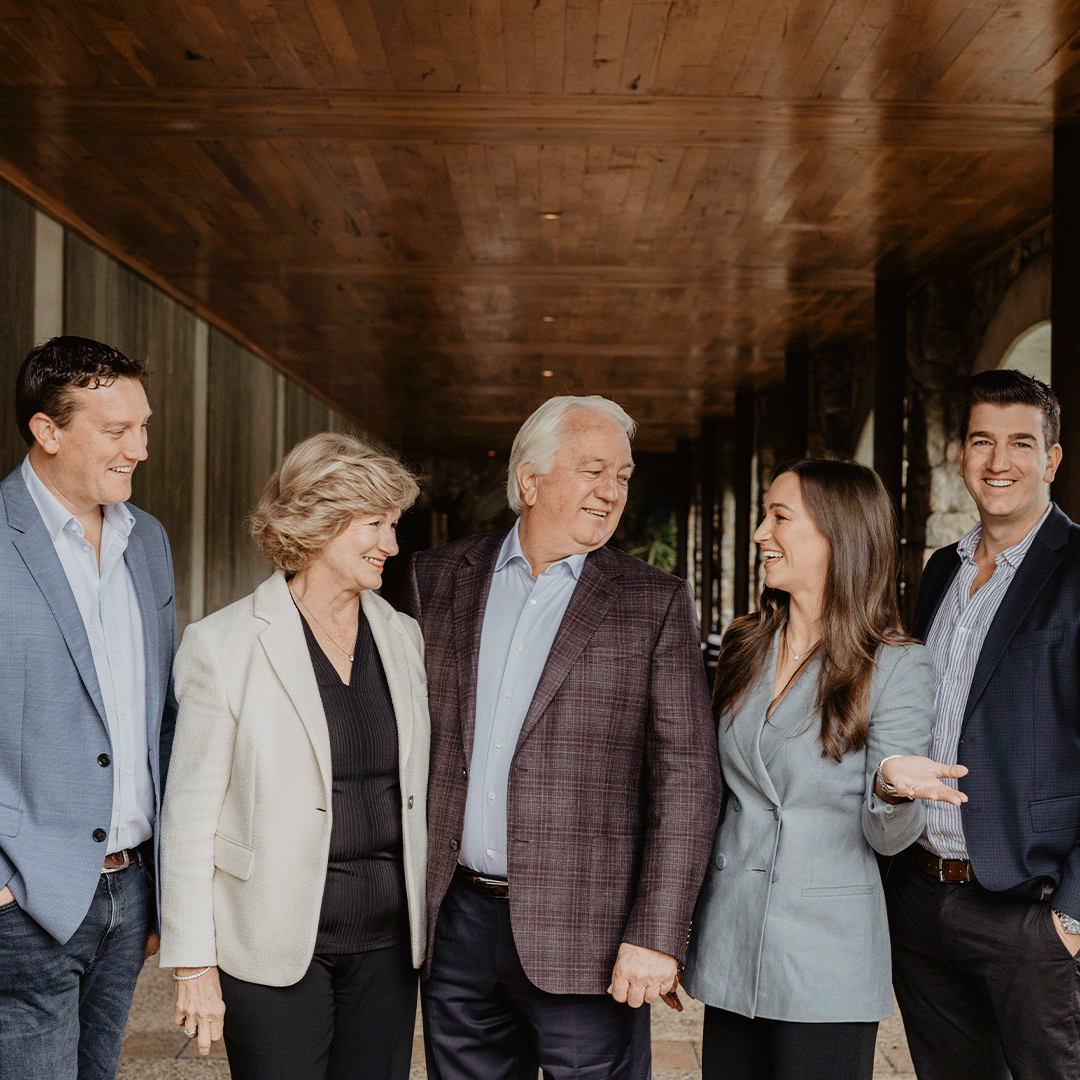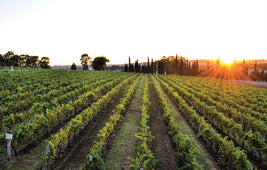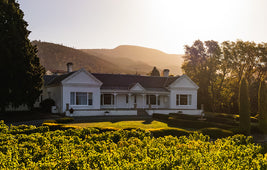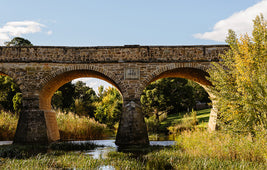Cabernet Sauvignon: A noble grape

If you have ever tried a red wine from Bordeaux, France, you will have tasted the Cabernet Sauvignon (cab-err-nay sew-vin-yon) varietal.
Whilst the Bordeaux region is the most famous in the world for Cabernet wines, there are many other regions that produce exceptional examples too, such as Margaret River in Western Australia and the Pyrenees in Victoria!
Today is Cabernet Sauvignon Day, so read on as we explore all things Cabernet Sauvignon, including how it became one of the most expensive and well-known wines in the world.
Cabernet Sauvignon: the King of grapes
Cabernet Sauvignon was first produced in the 17th century in Bordeaux, France after the spontaneous reproduction of Cabernet Franc and Sauvignon Blanc. It's pretty incredible to think this full-bodied, unctuous red was produced from a red and a white variety!
In comparison to other well-known French varietals such as Pinot Noir or Chardonnay, the discovery of Cabernet Sauvignon was relatively recent, however its rapid rise to fame was unprecedented and it is now the most widely planted grape variety in the world, with around 350,000 hectares under vine.
The rich, dark flavours that Cabernet Sauvignon produce became famous amongst wine lovers from around the world and plantings are now found across Europe and in the United States, New Zealand, Australia, Chile, Argentina and South Africa. Some of the most highly sought after and collected wines are those made from Cabernet Sauvignon. Today, 20 bottles of Bordeaux are sold around the world every second!
Cabernet Sauvignon in Bordeaux Blends
Cabernet Sauvignon rose to fame in Bordeaux, with the world renowned ‘Bordeaux blend’ of Cabernet Sauvignon, Merlot and small amounts of Cabernet Franc, Malbec, Petit Verdot and Carménère. Over 90% of the wines produced in this region are red wines made with Cabernet Sauvignon and Merlot.
If you want to try a Cabernet Sauvignon dominant blend, look for wines from the ‘left bank’ in Bordeaux – the Médoc (Pauillac, Saint-Julien, Saint-Estephe, Margaux and Pessac-Leognan) and Graves appellations. In comparison, wines from the ‘right bank’ of Bordeaux are Merlot dominant.
Interestingly, due to the increasing pressure of climate change on wine growing regions around the world, in 2019 Bordeaux became the first French region to allow 'foreign' varieties to be planted. This included a native Portuguese variety Touriga Nacional, which has caused severe controversy with many winemakers speaking out against these experimental plantings.
Fun fact
Bordeaux blends were once commonly referred to as Claret in the United Kingdom. Claret was one of the most popular wines amongst royalty and high society in medieval England. It was even rumoured to have been served at the wedding of King Henry II to Eleanor of Aquitaine in 1152!
The popularity of Claret continued for hundreds of years, with hundreds of thousands of litres being transported to the UK across the English Channel from France in the 1700s and 1800s.
Cabernet Sauvignon is Beloved in Australia
Australian wine pioneer James Busby first brought Cabernet Sauvignon to Australian shores in 1832, however unfortunately the first vineyard sites were unsuitable and most of the vines did not survive. Due to this, Cabernet Sauvignon was initially not thought of as a high-quality wine and fruit was mainly used as a blending component.
After plantings were made in other regions of Australia, such as Coonawarra and the Barossa in the late 1800s, it became apparent that certain regions had the ideal soil and climate for Cabernet Sauvignon and single varietal expressions became much more popular. The variety eventually made its way to Margaret River in the 1960s and arguably put this small Western Australian wine region on the world stage.
Australia is now home to the world’s oldest producing Cabernet Sauvignon vines, planted in 1886 in the northern Barossa, South Australia, however it’s more recent rise to fame in Australia can be shown in the numbers – in 1966 there were only 620 tonnes of Cabernet Sauvignon and nowadays there are over 260,000 tonnes crushed annually!
Fun fact
If you have seen the movie ‘Bottleshock’ you may be aware of the Paris Judgement, where wines from California were blind tasted against their French counterparts in the late 1970s. In this tasting, both Chardonnay and Cabernet Sauvignon wines from California were chosen in favour of the French wines, causing huge uproar amongst the French judges. This tasting and the media frenzy that followed, really put Cabernet Sauvignon from 'New World' wine countries on the map.
Common Cabernet Sauvignon characteristics
Cabernet Sauvignon is a late ripening vine that prefers moderate, dry regions. If it’s too hot the fruit characters become less defined, but can still be used in blends – adding tannin structure and body to the wine.
High quality Cabernet Sauvignon is known for its intense colour, firm tannin structure, rich dark fruits and herbal notes. Often extremely full-bodied when young, this is a wine that improves with age.
Because Cabernet Sauvignon is related to Sauvignon Blanc, it shares a common aroma family called methoxypyrazines – famous for green capsicum aromas and flavours.
Other common Cabernet Sauvignon aromas and flavours are:
- Blackcurrant
- Blackberry
- Black cherry
- Cedar
- Menthol
- Eucalyptus
- Olive
- Tobacco
- Chocolate
Cabernet Sauvignon loves food
The acidity and tannins in Cabernet Sauvignon make it a wine that pairs excellently with food. Think rich meat dishes such as lamb, beef, game and braised meat dishes like ragu.
Single Varietal Cabernet Sauvignon
Deep Woods Estate 2021 Reserve Cabernet Sauvignon
"From the earliest plantings (in 1987) of the estate. It begins piling on points with the bright, clear colour and doesn't stop with the bouquet of blackcurrant, bay leaf and airy spices, then flowing on in elegant, medium-bodied mode to a perfectly balanced and mouth-watering finish. Something quite special in its Margaret River context."
- 98 Points, James Halliday, The Weekend Australia Magazine 2023
Evans & Tate 2018 Redbrook Reserve Cabernet Sauvignon
Best in Show, 97 Points - Decanter World Wine Awards 2023
"Okay, here's the thing. I loved this wine when first tasted last year and gave it very high points. But the extra year has revealed even more and has prompted me to add another notch to the score. Most noticeably a glorious, perfumed fragrance has emerged. It's from the wonderful 2018 vintage, which continues to amaze with its red wines in particular. Leafy black fruits on the nose with a trace of brick dust and bay leaf, black olive. The palate is smooth and seamlessly structured with fine minerally tannins. A super wine with years ahead of it."
- 97 Points, Ray Jordan's WA Wine Review 2024
Dalwhinnie 2020 Moonambel Cabernet Sauvignon
"It's easy enough to list the flavours: spearmint, boysenberry, dark chocolate and pure blackcurrant, but it's the arrangement and more so the flamboyant flourish of them that really impresses. This is Dalwhinnie in dynamic good form. Integrated tannin ripples through the back half of the wine, as do sweet woodsmoke characters, and the finish is full of running and then some."
- 96 Points, Halliday Wine Companion 2024
Deep Woods Estate 2022 Single Vineyard 'G5' Cabernet Sauvignon
“This Single Vineyard Cabernet Sauvignon comes from the Gunyulgup Block 5 Vineyard in the Yallingup Hills subregion in the far north of Margaret River. Old vines are planted on deep gravel loams, and an east-facing slope captures the morning sun. This block delivers exceptional balance and intensity; the resulting wine is a delicious example of single site Margaret River Cabernet Sauvignon."
Chief Winemaker, Julian Langworthy
Cabernet Sauvignon Blends
Deep Woods Estate 2021 Single Vineyard Cabernet Malbec
"At once powerful yet contained with the varieties (percentage split unknown) beautifully matched. While the classy cabernet aromas and flavours come through, they are rendered more savoury by the malbec and oak. The fuller-bodied palate is alive and vibrant, flavours build and the tannins have presence, all textural and ripe. The finish lingers long as will this wine as in at least two decades."
- 96 Points, Halliday Wine Companion 2024
Evans & Tate 2020 Redbrook Estate Cabernet Merlot
"While Cabernet Sauvignon and Merlot are stamped on the label, percentages unknown even if the latter adds lots of its positive attributes to the wine. A dark red/inky hue laden with mulberries, plums, cassis and a baker’s cupboard full of spices with wafts of tobacco, menthol/eucalyptus. Full bodied and densely packed with flavour and no shortage of structure or tannins. If you imagine being at a rave, this wine is the DJ mixing it right up."
- 95 Points, Halliday Wine Companion 2024
Deep Woods Estate 2021 Cabernet Merlot
"This reveals itself gently as it’s not a showy wine but it is elegant and lovely. Delicate aromas, a core of sweet fruit tempered by savoury inputs of woodsy spices, menthol and powdery yet super fine tannins with bright acidity driving the long finish."
- 95 Points, Halliday Wine Companion 2024
Browse all Fogarty Wine Group Cabernet Sauvignon wines and blends here and be sure to celebrate International Cabernet Sauvignon Day with a glass of wine and some delicious food!



























